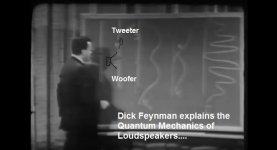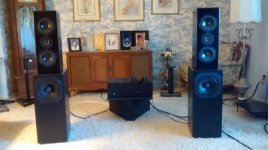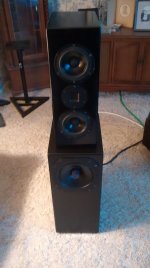Shane,
are you experiencing any lack of SPL at HF ? What is the total circuit filter you're
using right now?
are you experiencing any lack of SPL at HF ? What is the total circuit filter you're
using right now?
Nope. It's great! It worked out really well!
I am using the filter suggestion from Solen for the top end. The bottom is simply 1mh 15uf plus the series filter .33mh 8.2 ohms 22mf.
As they're burning in, the drums are really alive! It cost me a thousand bucks to hear a snare drum and ride cymbal 😀
I am using the filter suggestion from Solen for the top end. The bottom is simply 1mh 15uf plus the series filter .33mh 8.2 ohms 22mf.
As they're burning in, the drums are really alive! It cost me a thousand bucks to hear a snare drum and ride cymbal 😀
Last edited:
No, it's the top Marantz Integrated before you get in to the reference series, PM 8005.
I run the tweet on B channel with some silvered copper wire and kimber connects. The bass runs on B channel with 14+16ga together, kimber connects.
I run the tweet on B channel with some silvered copper wire and kimber connects. The bass runs on B channel with 14+16ga together, kimber connects.
Ok, why do you need a series RLC in parallel with amp out then?
This network is making your amp deliver more current than you
need and it's not increasing SPL.
This network is making your amp deliver more current than you
need and it's not increasing SPL.
It has improved the midrange a bit. TBH, not much of a difference. I am going to make a small PC board and try the Zoebel Solen suggested too. I can switch them out... see if it makes any likeable difference.
The filter I added is simply sitting on my desktop wired to the binding posts around back of the cabinet.
The filter I added is simply sitting on my desktop wired to the binding posts around back of the cabinet.
You're wasting time with this RLC and it's doing nothing
to the midrange SPL while it's drawing current for nothing.
Don't take my word for it. Ask any expert speaker designer.
Those kind of filters minimize SPL fluctuations when you use
aplifiers with high output impedance, like tube amps.
to the midrange SPL while it's drawing current for nothing.
Don't take my word for it. Ask any expert speaker designer.
Those kind of filters minimize SPL fluctuations when you use
aplifiers with high output impedance, like tube amps.
You utter HERETIC Shane! 😀It has improved the midrange a bit. TBH, not much of a difference. I am going to make a small PC board and try the Zoebel Solen suggested too. I can switch them out... see if it makes any likeable difference.
The filter I added is simply sitting on my desktop wired to the binding posts around back of the cabinet.
How dare you join the Joe Rasmussen camp and believe that flat impedance is a GOOD THING! 🙄
http://www.diyaudio.com/forums/multi-way/285062-joe-rasmussen-usher-s520-current-compatible-crossover.html
Joking aside, quite a good and exact correction, IMO. You seem to know what you are doing. 😎
Whenever Steve doesn't have anything technical to add, he introduces
cheerleading fan club arguments which turns things around in a truly
spectacular way. Jokes aside. 😀
cheerleading fan club arguments which turns things around in a truly
spectacular way. Jokes aside. 😀
Lots of things to like about this set-up! They are still burning in but I can tell they're gonna be pretty sweet 🙂
TBH, Lojzek, I always defend the right of a person to try out their own ideas. Speakers aren't fixed, but breaking news IMO.Whenever Steve doesn't have anything technical to add, he introduces
cheerleading fan club arguments which turns things around in a truly
spectacular way. Jokes aside. 😀
This is my faith. In the end, time will tell who is right. TBH, if you listen to this forum, you will find ignorance at every corner. It's all very well to say that amplifiers are perfect and zero impedance, but having built them, I find them riddled with inaccuracies.
Similarly with our speakers, you simply can't get away from the Uncertainty Principle. If anybody had designed the perfect speaker, there would be no more to say. Finished. Perfect. Reality, however, isn't the same thing as illusion. It's built into the Universe.
Hope you get it.
Attachments
Don't take my word for it. Ask any expert speaker designer.
Those kind of filters minimize SPL fluctuations when you use
aplifiers with high output impedance, like tube amps.
Yes, it does that with tube amps, that is not disputed. It works exactly as you say. But there are a number of 'expert speaker designers' that still use RLC and for reasons that is not about the amplifier Z modulating the FR.
I even use RLC on the bass. In a reflex EQ the upper peak, above the saddle (some of the lower peak will be lowered too, but not flat) and in a sealed box, it is often possible to make it entirely flat, like this 2-way design I did about six years ago:

Note what happens to both impedance and electrical phase. The above is an actual measurement, not modeling.
And you are right, it makes the speaker very immune to FR fluctuations - but a lot work for just that?
Steve, I never intended to create a 'camp'.

It's odd. Maybe my hearing is screwed up. After a life playing in rock bands when I was young all the way through 14 years as an academic in music composition; every bass driver crossover network I try (2nd order BW), there is never enough capacitance in the shunt. If the math says 10mfd, I end up going for at least 15. Sometimes, even that's not enough.
I guess it's one of my "bugaboos". Hot midrange drives me crazy. It's one of those situations where I say:
"math doesn't sound good".
I guess it's one of my "bugaboos". Hot midrange drives me crazy. It's one of those situations where I say:
"math doesn't sound good".
No, tuning a speaker by ear is tremendously important for the final sound. 😀
Flat frequency response tells you zip about whether it wins a cigar. Which is why I'm so footloose on modelling.
The classic midrange dip makes poor recordings sound good:
Designing Loudspeakers - WD25T EX - The next step
There's a lot to read there, and that's only half of it. A lot of near-solutions to the problems. Your MTM seems to be rather good. I like what I'm seeing here. Now you got to fiddle with it. The classic D'Appolito is a flat power BW3 design, rather than LR2, which are actually quite skilled things and a bit of a lost art. 😀
Flat frequency response tells you zip about whether it wins a cigar. Which is why I'm so footloose on modelling.
The classic midrange dip makes poor recordings sound good:
https://sites.google.com/site/undefinition/classix-iiPaul Carmody said:Although it doesn't quite show up on the Frequency Response graph, the Classix II are voiced with a slightly "relaxed" midrange. The bass response is rock solid down into the mid 30 Hz range. The impedance load presented by the Classix II are an easy load for any amp to drive.
Listening Impressions
I know you'll think I'm kidding, but of all the speaker designs I've done, if I could only keep a handful, these would be near the top of my list. Why? Because not everything I listen to is all that well-recorded--and that's where the Classix II really shine. For example: give them a grungy rock album and they will run with it. Hip Hop, R&B, Pop, Metal, Country--all stuff we spent so many hours of our lives listening to, developing emotional ties to--that music usually doesn't stand much of a chance on a true HiFi set of speakers. But as I said, the Classix II have a "euphonic" quality about them. They "gloss over" many of the problematic details of popular music (that an "audiophile" speaker would glare at you with), but at the same time are engineered to be revealing enough that most people would be surprised to hear new things in favorite old recordings.
Designing Loudspeakers - WD25A The Final CrossoverPeter Comeau said:LISTEN AGAIN
LspCAD is a great tool, but only when you use its results to feed into your own listening process. The technique is to use LspCAD to predict the measured results, then listen, make adjustments, feed these back into LspCAD, adjust to match the target slopes, listen again and so on. This is a process of iteration. Sometimes the results come quickly, sometimes it takes days or weeks to achieve the ‘perfect’ performance.
In this case the results were good, very good, with high quality source material. But that’s not everything. Good quality recordings can often fool you into believing that the speaker is ‘perfect’, but I find that a few poorer quality discs, what I call my ‘problem’ CDs, highlight errors that may otherwise not show up.
These ‘problem’ discs can be relatively modern recordings, such as Tears For Fears ‘The Seeds Of Love’ or older master tapes transcribed to CD like The Rolling Stones ‘Forty Licks’. The latter should be a fascinating trip through rock and roll music and recording techniques from the ‘60s onwards, even though the early singles are definitely ‘lo-fi’ they should still be listenable.
Largely it comes back to this question of balance between bass and treble. If the treble output is a tad too high the speakers will sound bright and detailed but overbearing and ear-rippingly harsh on these early recordings. Similarly a touch too much bass and the music slows to a crawl, percussion sounds heavy and bloated and the early recordings come across as coloured and wooden.
Then there is the midrange. One way of overcoming the compressed, mono mixed, squeezed-through-a-tube vocals of the ‘difficult’ recordings is to recess the midrange a little producing that apparently spacious ‘depth’ so beloved of audiophiles.
This may clean up the sound of difficult records and make them sound warmer but the overall effect is to push vocals too far into the background leaving them swamped by the rest of the band. Clearly that isn’t right, either, it’s just an acoustic trick.
Designing Loudspeakers - WD25T EX - The next step
The Ariel, Part IILynn OLson said:Even though the Vifa midbass units measured beautifully flat with a textbook 2nd-order Bessel rolloff, something wasn't quite right. The mids were too aggressive, smooth MLSSA curves notwithstanding. When you set down the microphone and actually listened to music and pink-noise, it was quite obvious. So I took the path of least resistance, thought a little while, and picked a multi-tapped inductor (L5) from North Creek Music Systems so I could play around with the woofer rolloff.
I shut off the tweeters and just listened to the midbass units, adjusting the tapped inductor as I walked around the room. Much better, but not home free yet. I picked out several different capacitors and increased the rate to 2nd-order, starting with a low-Q Bessel slope. The original midrange coloration disappeared, replaced by a new one about an octave or two higher, near the corner of the crossover slope. Hmm, what's going on here? Adjusting the filter Q by changing the C/L ratio didn't fix the problem, so I took the direct approach and added an R in series with the C6 capacitor. Ah. That sounded good. The MTM coloration was gone for the first time. How interesting.
Now it was time to have a little fun. I wired a L-pad to 15 feet of cable, connected it in series with the C, and walked around the room while I turned the pot. There was a critical value at about 1/3 of the rotation; below that, MTM coloration, above that, all gone. Turn the pot all the way up, and the mids reverted to the L-only sound. I repeated this several times, marked the value on the pot, and measured the resistance. It turned out that 3 ohms was the critical threshold, so I wired two 6.8 ohm resistors in parallel and left it at that.
There's a lot to read there, and that's only half of it. A lot of near-solutions to the problems. Your MTM seems to be rather good. I like what I'm seeing here. Now you got to fiddle with it. The classic D'Appolito is a flat power BW3 design, rather than LR2, which are actually quite skilled things and a bit of a lost art. 😀
Just clearing up unfinished business here.
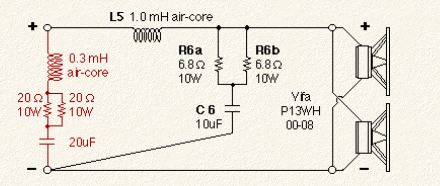
I think Lynn's bass filter is worth a go. I really don't know why it might work better with valves than solid-state, but I find these near Zobel bass shunts sound very musical. It may be that a 6 or 7.5R bass shunt on a 8 ohm driver is some sort of optimal voice-coil damping.
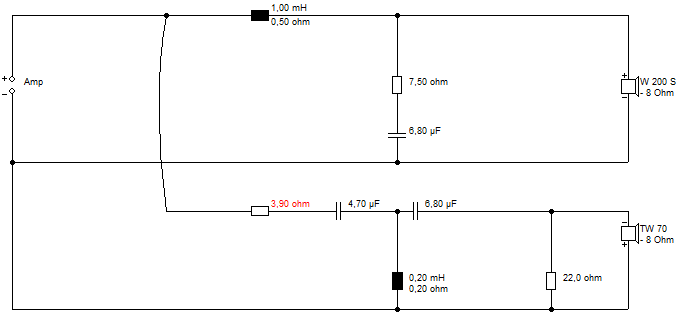
Of course, you halve it with two drivers in parallel.

I think Lynn's bass filter is worth a go. I really don't know why it might work better with valves than solid-state, but I find these near Zobel bass shunts sound very musical. It may be that a 6 or 7.5R bass shunt on a 8 ohm driver is some sort of optimal voice-coil damping.

Of course, you halve it with two drivers in parallel.
The classic midrange dip makes poor recordings sound good
I've heard treble dips at 2.5-3khz and 6-9kHz can help but I didn't know about this midrange dip. At what frequency?
I have now added a low frequency cabinet below. I wouldn't call this a "sub". It's simply crossed-over where the 5 inch Seas rolls off. It might overlap "slightly" but I will know more as they burn in, and make adjustments. I've built a basic BW 3 @125hz
8mh, 411mfd, 2.5mh were the parts I had in stock. I built these for 50 bucks so I am not complaining.
8mh, 411mfd, 2.5mh were the parts I had in stock. I built these for 50 bucks so I am not complaining.
Attachments
Last edited:
- Status
- Not open for further replies.
- Home
- Loudspeakers
- Multi-Way
- Seas CA15RLY X2 cabinet volume suggestions
